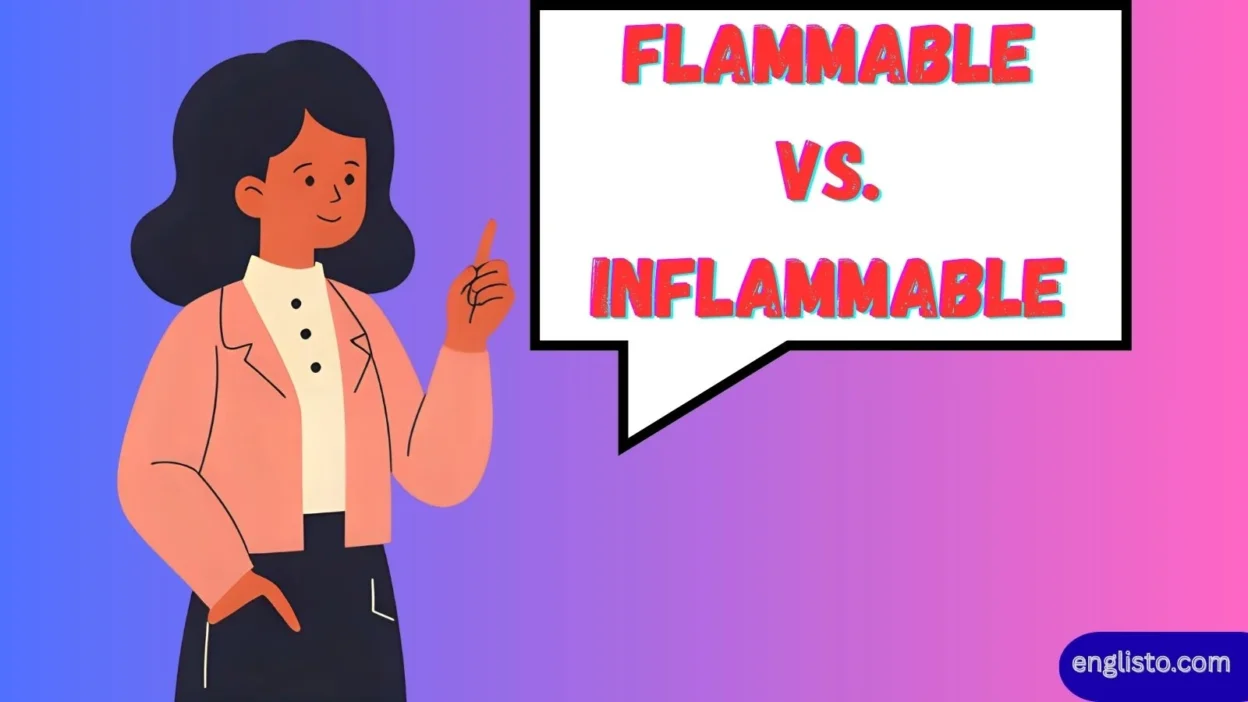Language is full of traps, and few are as puzzling as the words flammable and inflammable. At first glance, many assume they’re opposites—after all, doesn’t the prefix in- usually flip a word’s meaning? But here lies one of English’s most dangerous quirks. Both words actually mean the same thing: “able to catch fire easily.” Flammable vs Inflammable.
This confusion isn’t just academic—it has caused real-world accidents, safety hazards, and even deaths. In fact, the misunderstanding grew so serious that safety organizations, regulators, and manufacturers eventually discouraged the use of “inflammable” altogether. Today, you’re far more likely to see “flammable” on warning labels, fuel containers, and safety manuals.
This article dives deep into the story of flammable vs. inflammable—their history, meaning, safety implications, and why modern usage prefers one over the other. Along the way, we’ll explore fascinating word origins, safety guidelines, and practical examples that could literally save lives.
The Origin of the Words
A Latin Root That Lit the Fire
Both terms come from the Latin word inflammāre, which means “to set on fire” or “to inflame.” The root flammāre (“to flame”) comes from flamma (“flame”), while the prefix in- here doesn’t mean “not”—instead, it works like “into.” So inflammāre literally means “to set into flames.”
- Flammable was derived later from the same Latin root, built to avoid confusion.
- Inflammable traveled directly from Latin into English in the early 1600s.
By the 19th century, both terms were widely circulating. Unfortunately, because in- so often negates (like in invisible or inflexible), people instinctively assumed inflammable meant “not flammable.”
Read More: Curricula vs Curriculum: Understanding the Real Difference
Why the Confusion Happened
The English language borrowed heavily from Latin and Norman French, especially after 1066. Prefixes like in-, im-, ir-, and il- nearly always mean “not.” For example:
- Incapable = not capable
- Inflexible = not flexible
- Impossible = not possible
So when people saw inflammable, their instinct told them it meant the opposite of flammable. This wasn’t just a grammar slip—it was a life-threatening misunderstanding.
“The problem wasn’t with science. It was with language itself.”
By the 1920s, the National Fire Protection Association (NFPA) and other regulators noticed this confusion was leading to accidents. Fuel containers marked “inflammable” were mishandled, fires spread in warehouses, and public safety was at risk.
Flammable vs. Inflammable: Meaning and Usage
Here’s a quick table to make the meanings crystal clear:
| Word | Meaning | Example Usage | Modern Status |
| Flammable | Easily catches fire, burns rapidly | “Gasoline is highly flammable.” | Preferred term |
| Inflammable | Easily catches fire (same as flammable) | “This mattress is inflammable.” | Discouraged |
| Nonflammable | Will not burn or ignite | “Steel is nonflammable.” | Correct opposite |
| Combustible | Capable of burning but less quickly | “Wood is combustible but not as flammable as petrol.” | Accepted |
Notice how both flammable and inflammable are synonymous. The real opposite is nonflammable, not inflammable.
Safety First: Why the Shift Happened
In the 1950s and 60s, safety organizations began campaigning to replace “inflammable” with “flammable.” The British Standards Institution (1959) and later U.S. regulators advised manufacturers to use “flammable” exclusively.
Why? Because clarity saves lives. Imagine a gasoline drum labeled “inflammable” in a poorly lit warehouse. A worker might mistake it for safe storage and place it near sparks or welding equipment. The result? A catastrophic fire.
Today, flammable dominates safety manuals, fire hazard signs, and international shipping labels. “Inflammable” still exists in dictionaries, but it’s considered ambiguous and outdated.
Real-Life Examples of Flammable and Inflammable Materials
Here are some common flammable materials you might encounter:
- Liquids: gasoline, kerosene, acetone, alcohol, petrol, paint thinners
- Solids: paper, wood, plastics, rubber, fabrics
- Gases: propane, butane, hydrogen, methane
And here are nonflammable or fire-resistant materials:
- Liquids: water, helium, liquid nitrogen
- Solids: glass, steel, concrete, ceramics
- Gases: carbon dioxide (CO₂), nitrogen
A side-by-side comparison:
| Category | Flammable Examples | Nonflammable Examples |
| Liquids | Gasoline, acetone, alcohol | Water, helium, liquid CO₂ |
| Solids | Paper, wood, plastic, fabric | Glass, steel, concrete |
| Gases | Hydrogen, propane, butane | Nitrogen, argon, carbon dioxide |
Grammar and Usage: Which Word Should You Choose?
As a writer, editor, or student, the safest choice is to use flammable. Dictionaries still list inflammable, but nearly every style guide (Oxford, Merriam-Webster’s Usage Notes, Chicago Manual of Style) recommends avoiding it in safety contexts.
Some key notes:
- Flammable is always the clearer choice in everyday writing.
- Inflammable may still appear in literature, historical texts, or older labels.
- Nonflammable is the correct opposite. “Unflammable” and “not flammable” are discouraged.
Mnemonic tip:
“Flammables and Inflammables Ignite Instantly.”
Both mean the same—so stick with flammable to avoid confusion.
Fire Safety Tips for Handling Flammable Substances
Knowing the language is only half the battle. Here are practical safety steps to reduce fire hazards:
- Storage: Keep flammable liquids in cool, ventilated areas away from sparks. Use secured cabinets.
- Handling: Avoid smoking, open flames, or welding near flammable materials.
- Transport: Label containers clearly; follow COSHH regulations and NFPA guidelines.
- Household: Aerosol sprays, deodorants, hair sprays, hand sanitizers, and cleaning agents are flammable. Store them safely.
- Industrial: Warehouses storing thousands of liters of petrol or alcohol must have fire suppression systems and trained staff.
A fire doesn’t need much—just fuel, oxygen, and a spark. With highly volatile substances, the danger multiplies instantly.
The Figurative Side: Inflammable Emotions
Interestingly, “inflammable” isn’t just about physical fire. Figuratively, it’s often used for emotions:
- “He has an inflammable temper.”
- “Crowds can become inflammable when provoked.”
In this sense, the word works like “easily ignited emotionally.” It describes anger, passion, or violence that bursts out rapidly—just like fire.
FAQs About Flammable vs. Inflammable
What is the difference between flammable and inflammable?
Nothing. Both mean “easily set on fire.” The safer, modern term is flammable.
Is nonflammable the opposite of flammable?
Yes. Nonflammable materials resist burning (e.g., steel, concrete, water).
Why do dictionaries still list inflammable?
Because it’s historically correct and still used in literature, but it’s discouraged in safety contexts.
Can inflammable mean “not flammable”?
No. That’s a false assumption. The correct opposite is nonflammable.
Why did safety organizations prefer flammable?
To prevent accidents caused by misinterpretation. “Flammable” leaves no room for doubt.
Conclusion
The debate between flammable vs. inflammable isn’t just about grammar—it’s about clarity, safety, and common sense. Both words mean the same thing: “able to catch fire.” But because the prefix in- misled people into thinking otherwise, regulators and manufacturers shifted toward the simpler, safer choice: flammable.
In modern English, especially when safety is at stake, flammable is the only smart option. Inflammable may remain in older texts or figurative speech, but on labels, warnings, and technical documents, clarity is non-negotiable.
Next time you see a can of gasoline, a drum of chemicals, or even a bottle of hairspray, remember: if it says flammable, treat it with respect. One spark is all it takes.



